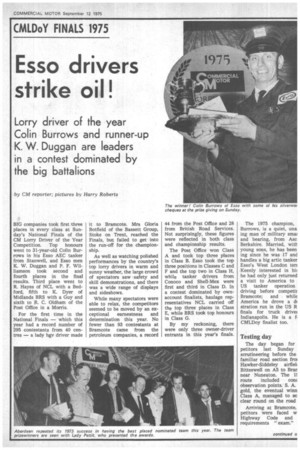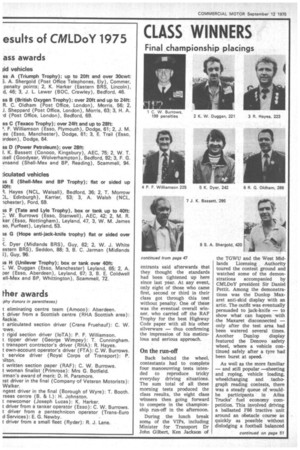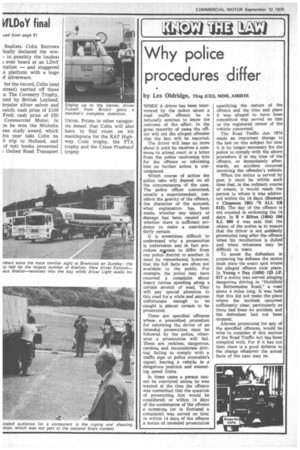Esso drivers strike oil!
Page 49

Page 50

Page 53

Page 54

If you've noticed an error in this article please click here to report it so we can fix it.
Lorry driver of the year Colin Burrows and runner-up K. W. Duggan are leaders in a contest dominated by the big battalions
by CM reporter; pictures by Harry Roberts BIG companies took first three places in every class at Sunday's National Finals of the CM Lorry Driver of the Year Competition. Top honours went to 31-year-old Colin Burrows in his Esso AEC tanker from Stanwell, and Esso men K. W. Duggan and P. F. Williamson took second and fourth places in the final results. Third place went to R. Hayes of NCL with a Bedford, fifth to K. Dyer of Midlands BRS with a Guy and sixth to R. C. Oldham of the Post Office in a Morris.
For the first time in the National Finals — which this year had a record number of 295 contestants from 40 centres — a lady hgv driver made it to Bramcote. Mrs Gloria Botfield of the Bassett Group, Stoke on Trent, reached the Finals, but failed to get into the run-off for the championship.
As well as watching polished performances by the country's top lorry drivers in warm and sunny weather, the large crowd of spectators saw safety and skill demonstrations, and there was a wide range of displays and sideshows.
While many spectators were able to relax, the competitors seemed to be moved by an exceptional earnestness and determination this year. No fewer than 93 contestants at Bramcote came from the petroleum companies, a record 44 from the Post Office and 28 from British Road Services. Not surprisingly, these figures were reflected in both class and championship results.
The Post Office won Class A and took top three places in Class B. Esso took the top three positions in Classes C and F and the top two in Class H, while tanker drivers from Conoco and Shell-Mex were first and third in Class D. In a contest dominated by ownaccount finalists, haulage representatives NCL carried off the top •three places in Class E, while BRS took top honours in Class G.
By my reckoning, there were only three owner-driver entrants in this year's finals. The 1975 champion, Burrows, is a quiet, una. ing man of military smai and bearing, from Asc Berkshire. Married, with young sons, he has been ing since he was 17 and handles a big artic tanker Esso's West London ten Keenly interested in hi: he had only just returned a visit to America to US tanker operation driving before competir Bramcote; and while America he drove a dt stration run in the US R finals for truck driver Indianapolis. He is a fi CMI,Doy finalist too.
Testing day
The day began for petitors last Sunday scrutineering before the familiar road section froi Hawker-Siddeley airfieli Bittesweli on A5 to Bran near Nuneaton. The 1! route included con( observation points. S. A. gold, the eventual winn Class A, managed to se clear round on the road Arriving at Bramcote, petitors were faced w Highway Code and requirements "exam." entrants said afterwards that they thought the standards had been tightened up here since last year. At any event, only eight of those who came first, second or third in their class got through this test without penalty. One of these was the eventual overall winner, who carried off the RAF Trophy for •the best Highway Code paper with all his other silverware — thus confirming the impression of his meticulous and serious approach.
On the run-off
Back behind the wheel, contestants had to complete four manoeuvring tests intended to reproduce tricky everyday driving situations. The sum total of all these morning tests produced the class results, the eight class Winners then going forward to compete in the championship run-off in the afternoon.
During the lunch break some of the VIPs, including Minister for Transport Dr John Gilbert, Ken Jackson of the TGWU and the West Midlands Licensing Authority toured the contest ground and watched some of the demonstrations accompanied by CMLDoY president Sir Daniel Pettit. Among the demonstrations was the Dunlop Maxaret anti-skid display with an artic. The outfit was eventually persuaded to jack-knife — to show what can happen with the Maxaret disconnected — only after the test area had been watered several times. Another Dunlop display featured the Denovo safety wheel, where •a vehicle continued safely after a tyre had been burst at speed.
As well as the more familiar — and still popular —sheeting and roping, vehicle loading, wheelchanging and tachograph reading contests, there was a steady queue of wouldbe participants in Ailsa Trucks' fuel economy competition. This involved driving a ballasted F86 tractive unit around an obstacle course as quickly as possible without dislodging a football balanced in a metal saucer on the front of the vehicle. Even here the fuel companies' domination continued, the winner being F. G. Townsend of Shell-Mex and BP, who recorded 15.22mpg to win a £50 prize.
After lunch the eight class winners — decided after feverish work by the results team — came together for the championship run-offs. The popular Mrs Botfield was not, however, among them. Nor were former champions Lloyd Richards of Heavy Transport (ECC) and Joe Dakin of Express Dairies, Ruislip. Both had been eliminated during the class run-offs. Reigning champion Lloyd's total of 154 penalities included • a maximum 110 score on one test imposed by a marshal who said Lloyd had got off his seat to see the road markings — which is not allowed. Despite an appeal to the stewards, Lloyd's chances were dashed. The stewards had a fairly busy day with a number of protests — reflecting, perhaps, the greater tension involved in the contest these days — but none was upheld.
Those people who did get through to the run-offs had to face a three-part contest to decide the winner. Part one involved the examination of a vehicle for any roadworthiness defects. Part two involved identifying a number of road signs and markings, and part three — the one the spectators had been waiting for — the manouevring tests.
Test one in the run-off — ins and outs — meant going forwards and backwards into two "garages." A limited number of movements were allowed for successful completion. Contestants used a Ryder CF van for this test. Test two, using a DAF platform truck, involved a complicated sequence of "boxes" entered forwards and backwards. The third test involved some very precise judging of width — this time in a Ryder box van — and test four was the old favourite, a height judging exercise with the use of a hydraulic crane.
Competition was tense as always — you could have heard a pin drop during some of the tests and in the end only 26 points divided the top finalists. Cohn Burrows inally declared the winto possibly the loudest ; ever heard at an LDoY ttation — and staggered e platform with a huge silverware.
for the record, Colin (and ltrant) carried off these s: The Coventry Trophy, ited by British Leyland; hrysler silver salver and vatch; cash prize of £100 Ford; cash prize of £50 Commercial Motor. In m he won the Michelin ean study award, which his year take Colin on 0 trip to Holland, and of text books presented United Road Transport Union. Prizes in other categories meant that Cohn will also have to find room on hit mantlepiece for the RAF Highway Code trophy, the FTA trophy and the Crane Fruehauf trophy.
















































































































